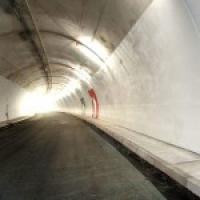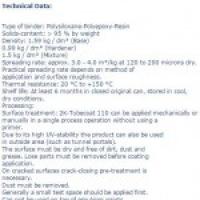| NTC Nano Tech Coatings GmbH |


| Registration Date | 27 Nov 2014 |
| Revision Date | 10 Jun 2019 |
| Share |
Construction Masonry Materials Product Number : 2K Tubecoat 110
CoatingThe resulting surface has a semi-gloss look and feel and features premium end-use qualities. In contrast to conventional coatings, the coating thickness amounts to no more than 100 to 200 ìm—an excellent example of savings in material thanks to nanotechnology. It features a high level of covering power, excellent anti-graffiti qualities and is both chemically and mechanically exceedingly durable. Excellent gloss retention comes along with a high level of UV resistance, weather resistance and freeze-thaw resistance.
Concrete coating is based on FUSCO®-technology. Silicon organic compounds are used in Tubecoat that react with the silicate structures at the surface of the concrete. They also have organic chains, the length and chemical nature of which can be varied.
This makes it possible – adapted to the relevant requirements – to set the surface characteristics between the extremes of ‘glass-like’ and ‘plastic-like’.
Thus by using FUSCO ® technology in Tubecoat several application steps can be saved; no deep primer is necessary. The surface that is to be coated need only be free of dust, grease and oil. Only coarse unevenness and cracks need to be removed with a preliminary treatment. The two-component coating material has a solid content of 98%. This almost completely avoids loads from organic solvents. The coating is applied using established procedures such as airless spraying or roller application. 1 kg of the coating material produces a coating surface of approximately 3 to 4 m². The coating hardens at normal ambient temperatures.
The resulting surface has a silky gloss appearance and is characterised by high quality functional qualities. Its coating thickness is, in contrast to a multiple of this in traditional coatings, only 100 to 200 μm – an example of the material savings achieved thanks to NTC technology. It displays high coverage capacity and good anti-graffiti properties and is extremely resistant to mechanical and chemical loads. Good gloss retention is combined with high UV, weather and de-icing salt resistance. The barrier effect against carbon dioxide and breathability are comparable to the values of conventional multi-layer systems and in some cases even better them.
A fixed pallet of standard colours is available. While high-pressure cleaners and cleaning materials with surfactants are general required to clean traditional coatings under the same application conditions, this can be carried out on Tubecoat coatings with just pressurised water. The products have been tested in the long term in many locations. Test areas that were applied in the Zingel Tunnel in Switzerland in 2007 are not displaying any damage to date and their easy-to-clean properties remain unchanged.
Parts of the Gubrist Tunnels in Switzerland have been coated with Tubecoat since 2009 and their performance is undiminished to this day. It has already been possible to noticeably reduce maintenance costs. This project was realised by NTC in cooperation with the Swiss Federal Office for Roads (Astra). The protection against carbonisation, UV effects, chloride ions and graffiti is the focus of a series of ongoing applications in Australia and lately in the USA, where various tunnels, motorway bridges and concrete crash barriers have been fitted with this innovative coating material in cooperation with the authorities and domestic construction companies.
There are also several projects underway in New Zealand. It was primarily the excellent anti-graffiti effect of the FUSCO®products that led to their use in the renovation of historical Spanish railway stations.
In project business interior and exterior areas on various cooling towers and power stations in Australia are currently being coated.
This is possible because of the short application times, the advantages of single-coat application and the guarantee of the enormously high chemical resistance that is necessary in the emission section of the cooling towers.